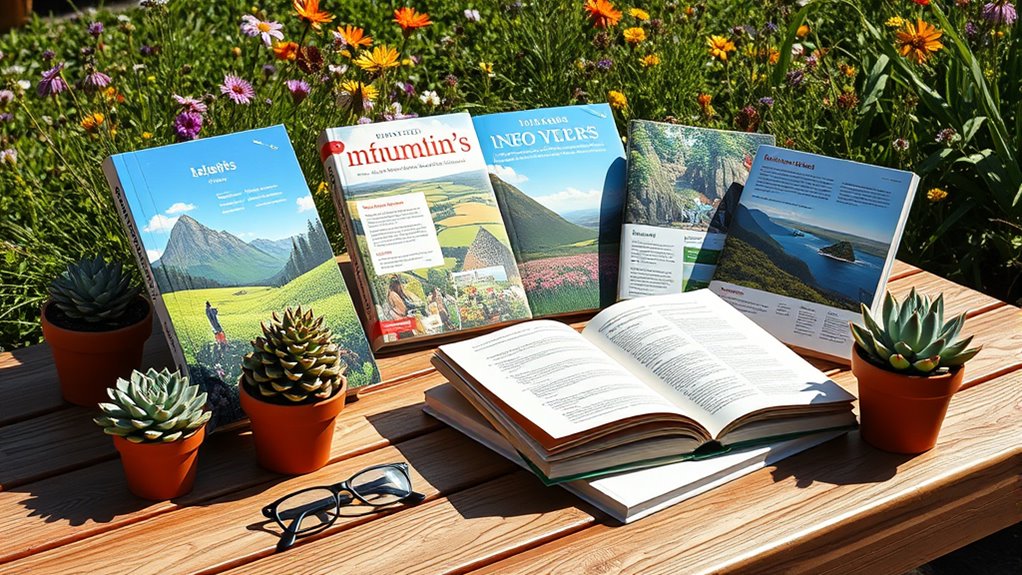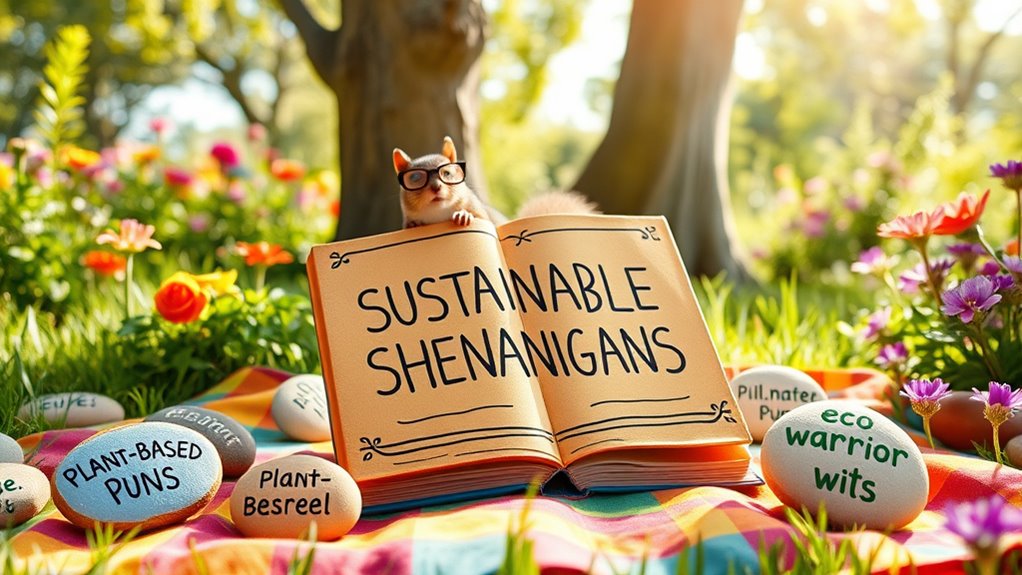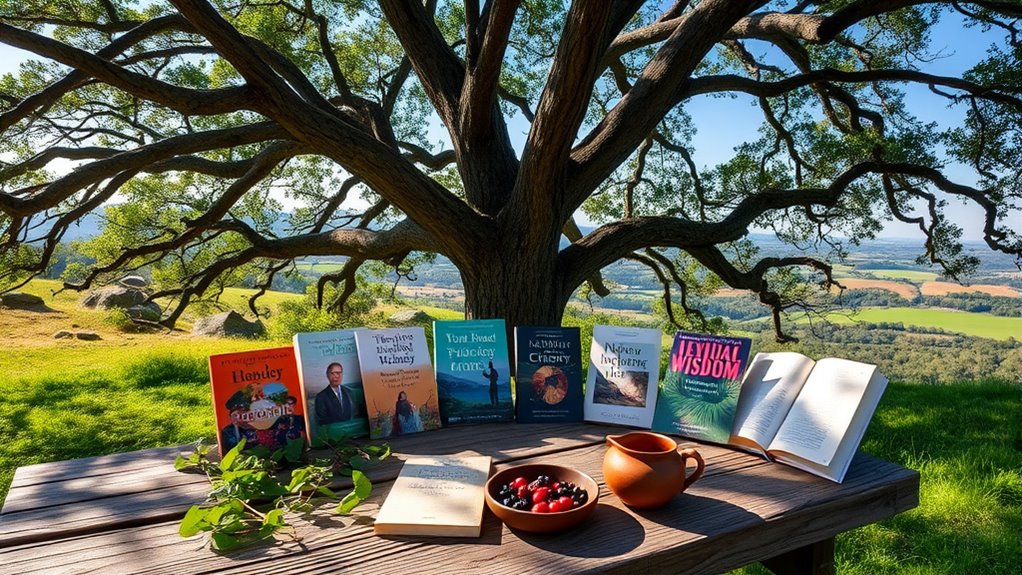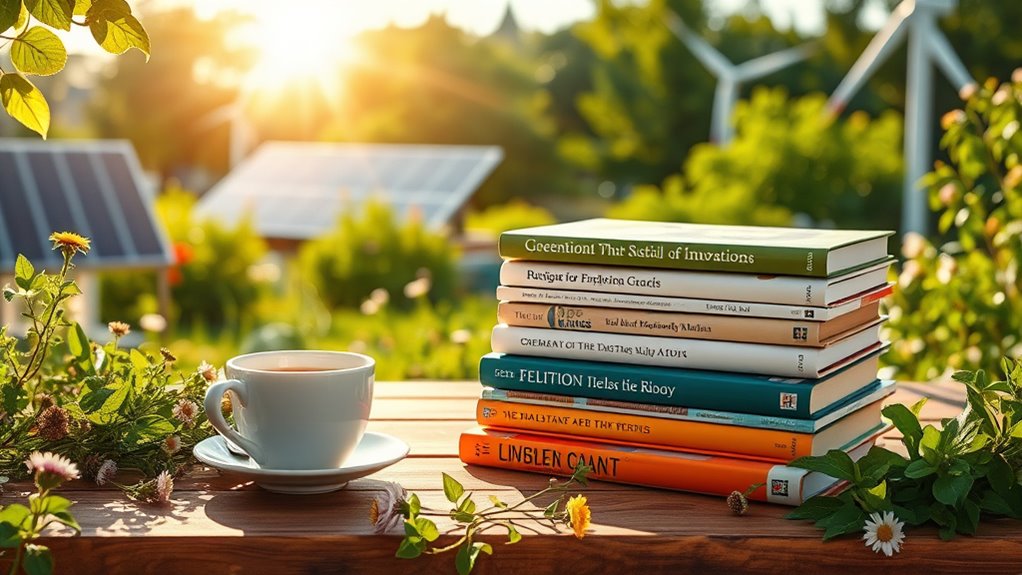For your summer reading list on sustainability, check out *Flight Behavior* by Barbara Kingsolver and *The Overstory* by Richard Powers, which tackle climate change. Books like Nnedi Okorafor’s *Noor* and Paolo Bacigalupi’s *The Windup Girl* critique society’s responses to ecological crises. Don’t miss works that explore economic systems and innovations in green technology. These narratives not only raise awareness but also inspire action. Keep exploring to discover even more insightful titles!
Key Takeaways
- Explore novels like *Flight Behavior* and *The Overstory* that address climate change and sustainability themes in engaging narratives.
- Consider works by authors such as Paolo Bacigalupi and Nnedi Okorafor that critique societal responses to ecological crises.
- Look for non-fiction books that provide insights into sustainable practices and environmental awareness.
- Investigate literature that discusses the importance of reusability and circular economy principles for waste management.
- Seek out diverse genres that cover various aspects of sustainability, from grassroots initiatives to economic systems.
Climate Change and Literature

As you dive into the world of literature, you’ll find that climate change has become a powerful theme, shaping narratives across genres. Novels like Barbara Kingsolver’s *Flight Behavior* and Richard Powers’ *The Overstory* explore environmental impacts, from global warming’s effects on monarch butterflies to the urgency of deforestation. J. G. Ballard’s *The Drowned World* presents a haunting vision of a future ravaged by rising sea levels, while Kim Stanley Robinson’s works blend science and politics in tackling climate issues. Nnedi Okorafor’s *Noor* and Paolo Bacigalupi’s *The Windup Girl* highlight diverse perspectives, critiquing societal responses to ecological crises. These stories not only entertain but also raise awareness, making them essential reads for anyone concerned about our planet’s future. Additionally, these narratives often explore societal responses to climate change and its impacts, reflecting a growing engagement with environmental themes in literature. The influence of renewable energy innovations is often woven into these tales, showcasing the potential for sustainable solutions in the face of climate adversity. Furthermore, many authors draw inspiration from sustainable living practices, illustrating how individual actions can lead to collective change in their narratives. For instance, the characters in these novels often engage with fresh juice benefits, highlighting how small lifestyle changes can contribute to a healthier planet.
Economic Systems and Environmental Action

While many people view economic systems as separate from environmental concerns, the two are deeply interconnected, influencing each other in significant ways. Market-based instruments like taxes and tradeable permits promote sustainable practices by encouraging businesses to reduce pollution cost-effectively. Through cost-benefit analysis, you can evaluate the economic benefits against environmental costs of new initiatives. Performance-based charges motivate companies to meet environmental standards, while levies on polluters generate funds for sustainability projects. Moreover, environmental economics highlights the importance of addressing negative externalities to correct market failures. By redirecting tax policies and strengthening regulations, you can help transition to a cleaner economy, ultimately decoupling economic growth from environmental impact and fostering a sustainable future. Additionally, understanding climate crisis solutions is essential for developing effective policies that align economic incentives with environmental sustainability. In states like Washington State, the absence of a state income tax on IRA withdrawals exemplifies how tax policies can influence financial decisions and promote sustainable investments. Furthermore, implementing risk management strategies can help align investment practices with sustainability goals, ensuring that economic pursuits do not compromise environmental integrity. Hydrogen fuel cells, with their zero harmful emissions, represent a promising avenue for integrating economic growth with environmental responsibility.
Women Leading the Climate Movement

Women are at the forefront of the climate movement, driving significant change and advocating for sustainable practices worldwide. They make up about 80% of those displaced by climate change, highlighting their vulnerability and need for empowerment. In contemporary art, the use of sustainable materials reflects a growing awareness of environmental issues, paralleling the advocacy efforts of women in the climate movement.
You’ll find that women are 60% more likely to advocate for environmental issues, making them key agents of change. Leaders like Christiana Figueres and Hilda Heine have championed climate action on global stages, while grassroots activists, such as Winnie Cheche, promote awareness in local communities. Holistic approaches adopted by these leaders often integrate social justice with environmental sustainability, ensuring that all voices are heard.
The Paris Agreement acknowledges the importance of women in decision-making, emphasizing their unique perspectives on resource management. By empowering women, we can develop inclusive policies that address climate challenges and promote resilience in affected communities. Additionally, understanding filial responsibility laws can help ensure that financial support for climate initiatives is sustainable and equitable across generations.
Humor and Climate Critique

Humor can be a powerful ally in the fight against climate change, breaking down barriers and inviting dialogue where fear often prevails. It engages audiences and makes climate issues more accessible, using satire and dark comedy to highlight the absurdity of our challenges. Books like Cranky Uncle vs. Climate Change and Stay Cool demonstrate how humor can debunk climate denial and ease emotional overwhelm. By making complex science relatable, these works foster resilience and motivate activism, helping you feel connected rather than isolated. Moreover, they aim to equip readers with skills to counter climate misinformation, making the conversation around climate change even more impactful. Additionally, humor can serve as a catalyst for change, encouraging individuals to rethink their behaviors and adopt sustainable practices. Emotional dysregulation is often a barrier to effective climate action, but humor can help mitigate these feelings and foster a proactive mindset. The thrill of adventure in tackling climate challenges critiques flawed arguments effectively, inviting you to laugh while learning. Ultimately, it creates a community around shared experiences, making it a vital tool for engaging with climate discourse positively.
Scenarios for a Sustainable Future

Engaging with climate issues through humor not only raises awareness but also sets the stage for envisioning a sustainable future. To achieve this, you need to consider scenarios that balance thriving communities and healthy ecosystems. The United Nations’ Sustainable Development Goals (SDGs) provide a roadmap for integrated economic, social, and environmental policies. By collaborating with stakeholders, you can co-develop positive visions that anticipate challenges like climate change and resource depletion. Transitioning from fossil fuels to renewable energy is crucial; it reduces greenhouse gas emissions and improves air quality. Moreover, achieving sustainability can limit the global temperature increase to 1.6°C under an integrated approach. Creating effective co-parenting plans can also help families navigate transitions while maintaining a focus on children’s needs and well-being. Additionally, adopting energy-efficient systems like heat pumps can significantly lower carbon emissions and enhance sustainability efforts. Regular maintenance of these systems can enhance their efficiency by up to 70%, ensuring they contribute effectively to environmental goals.
Conversations on Environmental Justice

As communities increasingly face environmental challenges, conversations around environmental justice are vital for fostering equitable solutions. This movement advocates for fair treatment of all people, irrespective of race, color, or income, ensuring that no community bears a disproportionate burden from environmental policies. It emphasizes meaningful community involvement in decision-making processes, addressing issues like environmental racism and inequality. You’ll find that key concepts such as procedural, geographic, and social equity shine a light on disparities that affect marginalized populations. The origins of this movement in the 1980s highlight its growth from a focus on local injustices to a global concern, with historical practices like redlining contributing to environmental hazards faced by vulnerable communities. Additionally, the need for adequate water sources in sustainable practices is crucial for enhancing local food security and resilience in the face of environmental changes. Engaging with community organizations and understanding their struggles can lead to impactful changes that promote justice for all. Furthermore, the integration of financial considerations for elderly care can support vulnerable populations in navigating environmental challenges that disproportionately impact them. Additionally, many communities rely on sustainable practices, such as foraging techniques, to enhance local food security and resilience in the face of environmental changes.
Indigenous Knowledge and Nature

Understanding environmental justice lays the groundwork for appreciating the invaluable contributions of Indigenous knowledge in addressing climate challenges.
Indigenous Peoples have maintained a historic balance with nature, offering sustainable practices like agroforestry and milpa farming that enhance biodiversity and sequester carbon. Their close connection to the environment allows them to detect climate changes early, fostering resilience through traditional adaptations such as cultural burning. Indigenous Peoples manage approximately 25% of the world’s land, housing significant biodiversity and carbon storage. Integrating renewable energy sources into these traditional practices can further enhance sustainability efforts and reduce reliance on fossil fuels. The use of traditional healing practices also reflects a sustainable approach to environmental stewardship that benefits the community. Healthy ecosystems provide essential services, supporting the intricate balance between Indigenous practices and environmental sustainability.
Indigenous Peoples’ sustainable practices and deep environmental connection foster resilience and enhance biodiversity in the face of climate change.
Traditional Ecological Knowledge (TEK) embodies intergenerational insights that emphasize minimal environmental impact and adaptive management. By integrating TEK with Western science, you can enrich research and develop effective climate solutions.
Recognizing and respecting Indigenous rights is crucial for fully incorporating this wisdom into climate policies, ensuring a sustainable future for all.
Grassroots Conservation Practices

While grassroots conservation practices may start small, their impact on local communities and ecosystems can be profound. These organizations engage local residents, fostering sustainable development and environmental stewardship.
For instance, initiatives like mangrove restoration not only combat climate change but also enhance community resilience. By promoting practices like organic farming and agroforestry, grassroots groups support sustainable livelihoods while improving biodiversity and soil health. Techniques such as streamside forest buffers and no-till farming help reduce pollution and enhance water quality. Additionally, the use of portable solar panels can provide renewable energy solutions for these practices, further supporting sustainability efforts. Furthermore, these local efforts often inspire broader changes, showcasing the power of community-driven solutions in addressing environmental issues. Implementing streamside forest buffers can significantly reduce nutrient and sediment pollution, benefiting both the ecosystem and local agriculture. Additionally, the adoption of renewable energy sources in these practices can further minimize environmental impact and reliance on fossil fuels.
Your involvement in these practices can lead to meaningful change, both locally and globally, making a significant difference in conservation efforts.
Sustainable Business Strategies

Sustainable business strategies are essential for modern companies aiming to thrive in an increasingly eco-conscious market. By integrating renewable energy sources, you can significantly reduce your carbon footprint, like REI does by sourcing 100% of its electricity from renewables. Environmental sustainability is crucial for businesses of all sizes, as it reflects a commitment to reducing negative environmental impact.
Emphasizing sustainable supply chains, as Patagonia does with fair labor practices and eco-friendly materials, promotes social responsibility. Implementing waste reduction programs, such as recycling initiatives, fosters a circular economy.
Forming strategic partnerships can enhance growth, allowing you to tap into new markets while sharing expertise. Lastly, focusing on eco-conscious product innovation ensures minimal waste and promotes sustainable consumption, ultimately solidifying your brand’s commitment to sustainability and attracting loyal customers.
Innovations in Green Technology

As the world grapples with climate change, innovations in green technology are becoming crucial in driving sustainable practices across various sectors. You can witness the impact of renewable energy advancements, like solar systems installed over water bodies and compact vertical wind turbines that fit urban settings. Battery breakthroughs, such as solid-state batteries, tackle energy storage challenges effectively. In agriculture, vertical farming and AI-driven precision farming optimize resources. Carbon capture technologies, like Direct Air Capture, are enhancing efficiency and scalability to reduce emissions. Innovations in energy efficiency, including smart buildings and IoT devices, help you manage resources wisely. Embracing these technologies not only promotes sustainability but also empowers you to contribute to a greener future. Additionally, advanced recycling methods address waste challenges by transforming materials into reusable substances.
Frequently Asked Questions
How Can I Start My Own Sustainable Reading Group?
To start your own sustainable reading group, begin by selecting a clear focus, like climate change or sustainable living.
Recruit diverse members who share an interest in sustainability. Set a consistent meeting schedule, and choose whether to meet in-person or online.
Curate a list of engaging books, ensuring everyone has access. Prepare discussion guides and activities to spark conversations, and foster a welcoming environment where everyone feels comfortable sharing their thoughts.
What Are Some Beginner-Friendly Books on Sustainability?
If you’re looking for beginner-friendly books on sustainability, start with “The Story of Stuff” by Annie Leonard; it breaks down complex concepts.
“101 Ways to Go Zero Waste” by Kathryn Kellogg offers practical tips for everyday changes.
“Green Living for Dummies” simplifies sustainable practices, making it accessible.
Lastly, “One Pot, Pan, Planet” by Anna Jones is great for cooking sustainably.
These choices will inspire and equip you to embrace a more eco-friendly lifestyle.
How Do I Choose Which Sustainability Issues to Focus On?
Did you know that nearly 1 million species are at risk of extinction due to human activity?
When choosing which sustainability issues to focus on, consider what resonates with you personally.
Think about your interests—whether it’s climate change, biodiversity, or environmental justice.
Research the current challenges and their impacts on your community.
Prioritize areas where you believe you can make a difference, and start engaging with those topics passionately.
Are There Online Resources for Discussing Sustainability Literature?
Absolutely, there are plenty of online resources for discussing sustainability literature!
You can join Reddit communities like r/Sustainability or r/ClimateChange to engage in lively discussions. Goodreads has groups dedicated to sustainability topics, too.
Consider participating in specialized online book clubs or exploring social media groups on platforms like Facebook and LinkedIn.
Academic networks and MOOCs also offer platforms for in-depth conversations about sustainability literature.
Dive in and share your thoughts!
Can Fiction Contribute to Understanding Sustainability Challenges?
Imagine walking through a forest, each tree a chapter in a story about our planet’s fate.
Fiction can illuminate sustainability challenges by weaving emotional narratives that resonate deeply with you. When you read about characters facing climate change or environmental justice, you connect on a personal level, inspiring empathy and action.
Through diverse perspectives and innovative solutions, these stories foster understanding, making complex issues feel relatable and urging you to reflect on your impact.
Conclusion
As you dive into these compelling reads, imagine the world transforming around you. Each page turns, revealing not just the challenges we face, but the vibrant solutions waiting to be discovered. What if you could be part of this change, igniting conversations and inspiring action? The clock’s ticking, and the future hangs in the balance. Will you take the plunge into these narratives that spark hope and innovation? Your journey toward sustainability begins now—are you ready?









